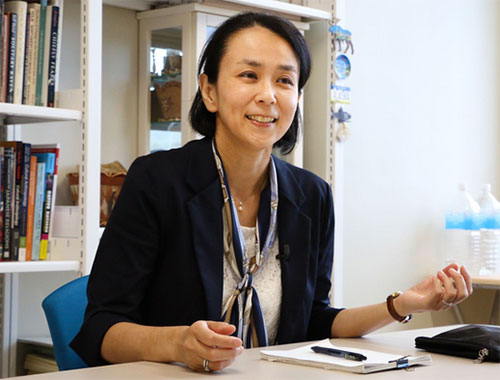Professor Hiroko Ikuta, an anthropologist at Kyushu University’s International Student Center, discusses her experiences living among two maritime Indigenous communities in Alaska. |
“I knew that tradition is always defined in the present in relation to the past. But I was wondering why different groups of people choose different aspects of culture as their tradition, and what they mean by tradition,” says Ikuta.
After two decades of living in Alaska, Ikuta has come to understand that an important traditional value Indigenous peoples perpetuate through dance is sociability.
“As long as dancing completes the task of caring for each other and attending to the wisdom of the Elders, be it ‘atuq’ on St. Lawrence Island or ‘Eskimo dance’ by the Iñupiat Barrow Dancers, both are tradition. From the Indigenous point of view, what matters is what these dances accomplish and not how they accomplish it.”
Ikuta lived in Alaska from 1999 to 2016, which includes time working in the Alaska Department of Fish and Game. She recalls these experiences in her recent book, The Sociality of Indigenous Dance in Alaska: Happiness, Tradition, and Environment among Yupik on St. Lawrence Island and Iñupiat in Utqia?vik.
Her main field site was St. Lawrence Island, a 90-mile-long island just 40 miles from the Russian mainland that is home to a community of approximately 1,400 Yupik people. The other community she studied is Utqia?vik, the northernmost human settlement on the American Continents, with a population of about 4,500 Iñupiat.
Over the last century, Indigenous peoples of Alaska have negotiated their place in the world with powerful outside forces, starting with the Yankee whalers in the late nineteenth century, Protestant missionaries, and the federal and state governments. The Protestant missionaries and Anglo-European settlers saw Indigenous dance as heathen practices. Under the assimilation policies by the government during the colonial period (1890s–1960s), Indigenous dance practice went underground.
“The discovery of oil in 1968 brought petroleum companies to the region. That’s when the paths taken by Yupik and Iñupiat greatly diverged economically,” says Ikuta.
The Alaska Native Claims Settlement Act (ANCSA) of 1971 was probably the most important political and economic development for the Alaskan Natives during the last century. The contrasting choices that the two Indigenous communities made regarding land rights has greatly impacted their contrasting dispositions toward Indigenous dance.
Following the ANCSA of 1971, Iñupiat in Utqia?vik chose cash economy and wage labor like almost all other Indigenous communities in the rest of Alaska, while Yupik on St. Lawrence Island chose ownership of the entire Island, forgoing any cash settlement or participation in the regional corporation system.
Iñupiat in Utqia?vik, along with other Indigenous communities in Alaska, lost most of their land—only 14% of Alaska belongs to Indigenous Peoples today—but became financially well-off. In this process, however, they almost lost touch with their Native language.
On the contrary, Yupik on St. Lawrence Island, following the decision to opt out of the ANCSA, have become one of the financially poorest communities in Alaska. But the entire Island today belongs to them and the Yupik language has remained with them.
“As the two groups diverged economically, so did their approach to Indigenous dances. On St. Lawrence Island, Yupik continue ‘atuq,’ the traditional dance event in jeans, while the dances in Utqia?vik are choreographed events. But despite these differences, they still share much in common,” observes Ikuta.
This was on display when the International Whaling Commission (IWC) banned whaling in 1977. While the two communities made contrasting decisions in the early 1970s regarding land claims, Yupik and Iñupiat came together to fight for hunting rights against the IWC’s ban on whaling, which challenged the use of modern hunting equipment—such as aluminum boats, outboard motors, Citizen’s Band radios, high-powered rifles, etc.—as a traditional means of subsistence.
Ikuta says, “While the IWC insisted that traditional whaling had to be conducted by traditional tools—otherwise it was contradiction—the use of contemporary equipment does not conflict with Indigenous cultural values in whaling as a traditional activity.”
“Be it modern or traditional, what defines ‘traditional’ for Indigenous whalers is whether or not they have accomplished ‘customary moral injunctions,’ which are ‘listen to the Elders’ and ‘treat the whales tenderly and with respect.’ Means do not matter.”
Yupik and Iñupiat came together to fight for hunting rights. It was also during this fight for hunting rights that they realized the potential of Indigenous dance to convince outsiders how “Indigenous” and “Eskimo” they were. Thus, having equipped themselves with Indigenous dance to prove their tradition, they hired lawyers and won the case against the IWC.
In her time studying Alaska, Ikuta found many more examples of Indigenous Peoples making diplomatic and thoughtful decisions for themselves, which she explains more in her book. “They were very efficient and tactful negotiators,” says Ikuta. Today, Ikuta specializes in environmental anthropology and teaches courses on Alaska, climate change, art and folklore at Kyushu University.
Edited By: Mary Kauffman, SitNews
Source of News:
Kyushu University
www.kyushu-u.ac.jp/en/
Representations of fact and opinions in comments posted are solely those of the individual posters and do not represent the opinions of Sitnews.
Send a letter to the editor@sitnews.us
SitNews ©2022
Stories In The News
Ketchikan, Alaska
Articles & photographs that appear in SitNews are considered protected by copyright and may not be reprinted without written permission from and payment of any required fees to the proper freelance writers and subscription services.
E-mail your news & photos to editor@sitnews.us
Photographers choosing to submit photographs for publication to SitNews are in doing so granting their permission for publication and for archiving. SitNews does not sell photographs. All requests for purchasing a photograph will be emailed to the photographer.

